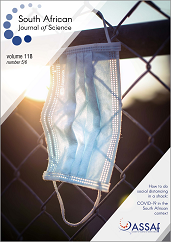COVID-19 and all-cause mortality in South Africa – the hidden deaths in the first four waves
DOI:
https://doi.org/10.17159/sajs.2022/13300Keywords:
COVID-19 deaths, excess deaths, South AfricaAbstract
Accurate statistics are essential for policy guidance and decisions. However, the reported number of cases and COVID-19 deaths are known to be biased due to under-ascertainment of SARS-CoV-2 and incomplete reporting of deaths. Making use of death data from the National Population Register has made it possible to track in near-real time the number of excess deaths experienced in South Africa. These data reveal considerable provincial differences in the impact of COVID-19, likely associated with differences in population age structure and density, patterns of social mixing, and differences in the prevalence of known comorbidities such as diabetes, hypertension, and obesity. As the waves unfolded, levels of natural immunity together with vaccination began to reduce levels of mortality. Mortality rates during the second (Beta) wave were much higher than mortality in the third (Delta) wave, which were higher than in either the first or the fourth (Omicron) waves. However, the cumulative death toll during the second (Beta) wave was of a similar order of magnitude as that during the third (Delta) wave due to the longer duration of the Delta wave. Near-real time monitoring of all-cause deaths should be refined to provide more granular level information to enable district-level policy support. In the meanwhile, there is an urgent need to re-engineer the civil registration and vital statistics system to enable more timely access to cause of death information for public health actions.
Significance:
This study highlights that in South Africa there were about three times the number of excess deaths from natural causes during 2020 and 2021 than reported COVID-19 deaths. Although the cause of death remains unknown, the strong temporal correlation between excess deaths and reported COVID-19 deaths within each province indicates that the majority of excess deaths were associated with COVID-19. Many countries have found it difficult to estimate excess deaths, or to identify and report COVID-19 deaths accurately, demonstrating the value of near-real time monitoring of mortality through the use and demographic analysis of data obtained from the country’s National Population Register.
Open data set: https://www.samrc.ac.za/sites/default/files/files/2022-02-09/Estimated%20deaths%20for%20SA%2007%20Feb%202022%20with%20adj2.xlsx
Downloads
Published
Issue
Section
License

All articles are published under a Creative Commons Attribution 4.0 International Licence
Copyright is retained by the authors. Readers are welcome to reproduce, share and adapt the content without permission provided the source is attributed.
Disclaimer: The publisher and editors accept no responsibility for statements made by the authors
How to Cite
- Abstract 5219
- PDF 1748
- EPUB 555
- XML 580
- Supplementary material 169













.png)